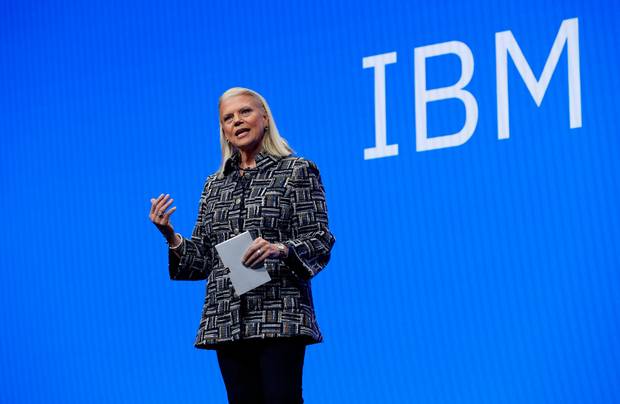
Here's What IBM Says Is The Future Of Tech
Keynote addresses, opening or otherwise, can tend to be a bit stiff and dry, overly grandiose or somewhat awkward for senior executives perhaps more at home in a board room than on a massive stage. But IBM Chairman, President and CEO Ginni Rometty not only took command for her CES 2019 opening address with aplomb but hit nearly every note on the scale when it came to dissecting the future of technology and opportunities for the business community.
While IBM is certainly not the newest nor considered coolest emerging tech kid on the block, the offering was a rather rich presentation for a number of reasons. Rometty manages to project the power of vision and commitment with a no-nonsense sincerity yet an approachable compelling manner that seemed right for the times. The solo delivery was interspersed with a fireside chat-meets-talk-show vibe with her fellow executive peers from various companies which at once both allowed the IBM power to be understood via use cases expressed in authentic conversations as well as provided for fluid pacing.

Rometty presented a significant case for "what's next," as she put it, in the technology industry. She spoke about the rising trend of deep data that will enable more efficient business via predictions and forecasts through the collection of data that exists; but yet is not truly collected and analyzed such as data from our fingernails which can be used to predict and/or detect health issues in advance to data from weather patterns that can be better analyzed to forecast air turbulence and in doing so, lessen fuel costs and increase passenger safety for airlines.
In order to help the audience better understand current and future business use cases regarding deep data, Rometty featured Delta Airlines CEO Ed Bastian to discuss how IBM and Delta have worked together to provide better service to customers from tracking luggage more efficiently to using facial recognition rather than passports to expedite security and customs areas at Atlanta airport (and plans for the company to expand such capability to all airports in the very near future).
Rometty later spoke on stage with Charles Redfield, Executive Vice President, Food at Walmart, regarding how IBM's blockchain technology helps the nearly 265 million grocery customers a week ensure that their food is safe. Redfield noted that prior to blockchain implementation that the process of tracking and investigating data on food from shelf-to-farm took seven days. With blockchain capability, the time decreases to just 2.2 seconds.
Rometty also noted that transparency that blockchain provided helps to create a system of trust between all parties involved and that this element will become even more important in the future for all businesses.
Moving from deep data Rometty then discussed what IBM terms Broad AI which will unify learning and reasoning. Midway between the one-task-in-one-domain version of artificial intelligence and that which mimics a human being, Broad AI will help companies decrease time to market with much less training data. This will mean a significant competitive advantage thanks to speed and agility. But Rometty is also keenly aware of the cry for a more holistic approach in discussing and leveraging AI. "What is vital is to make anything about AI explainable, fair, secure and with lineage, meaning that anyone could see very simply see how any application of AI developed and why," she said. The IBM CEO spoke also about the importance of ethics in the usage of data and awareness about bias within development as a mandatory part of the future of technology.
IBM also took the opportunity of the opening address to announce its IBM Q System One which leverages quantum computing for commercial advantage. Dr. Vijay Swarup, Vice President, Research and Development at Exxon Mobile spoke about how the company uses IBM technology to make strides in the development of energy grids and more while mitigating the risk of climate change and how such technology usage actually creates new energy solutions and its role in the future creation of understanding the very nature of energy itself.
While a bit lengthy at times, the collection of insights that the presentation offered was very solid and grounded.

But Rommety really demonstrated why she seems to be a world-class manager when she spoke in depth about the need to truly prepare society for the future so that it will "benefit the many and not the few." She explained how IBM has created several public-private partnerships to implement such programs as its Pathway-to-Technology high school programs that enable students to actually obtain a combination high-school diploma and associate's degree in six years without any debt and provide for entry-level positions within the technology arena in the process. "We call these 'new collar jobs', " she explained, proving that a practical approach in innovation that is measurable and taking place in real-time is possible.
Further, IBM also announced it's CTA apprenticeship coalition on stage, as well. This will expand the company's current strategy that it executes on its own. The power of which came alive on stage when Rometty introduced five IBM employees who come from very different career and ethnic backgrounds who took advantage of the company's current apprenticeship program and now work at IBM.
"This is what it means to me to build an inclusive society," she explained. Rometty remarked that successful businesses in the future, dare we add a successful culture, will be those that give everyone a chance from every walk of life who want to participate in the tech space the opportunity to do so on their own terms and be welcomed. That's a vision for which many are truly rooting.